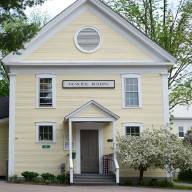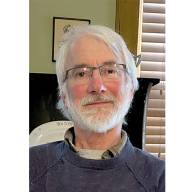Nearly 100 community members came out to learn more about the Mad River Valley Active Transportation Corridor project at a meeting late last month.
Spearheaded by Misha Golfman, executive director of the Mad River Path, and Sam Robinson, community planner for the Mad River Valley Planning District, the March 26 meeting brought people together at Waitsfield Elementary School to discuss and vote on potential routes for the proposed multi-use path connecting Warren to Middlesex. This public meeting, titled the "Presentation of Alternatives," allowed local residents, municipal leaders, and other stakeholders to engage directly with the project team and provide input into the path's design.
The project aims to improve pedestrian and cyclist safety, provide a sustainable transportation alternative, and enhance the recreational and economic opportunities across the Mad River Valley. The corridor will connect towns along Vermont Route 100 (VT-100) and, if approved, will be a key component in the region’s broader transportation plan.
The initiative builds on previous planning efforts, including the MRV Moves Active Transportation Plan developed by the Mad River Valley Planning District (MRVPD) in 2016. MRV Moves envisioned a cohesive, multi-town approach to recreational trails and non-motorized transportation facilities, integrating them with economic development, enhancing visitor experiences, improving residents' quality of life, and expanding transportation options.
INTERACTIVE FORMAT
The March 26 event was designed as an interactive experience to allow attendees to visualize the three potential route options for the corridor. Eight stations were set up throughout the room, each offering detailed information about the project’s goals, the benefits of the different alternatives, and the alignment options under consideration. Attendees had the opportunity to examine 3D renderings of the proposed paths and explore maps created by the project’s consulting engineer, Vanasse Hangen Brustlin, Inc.
Each station provided insight into how the three alternatives would affect various segments of the corridor, from Warren Village to Middlesex. The three proposed options were:
- Alternative 1: Minimum Build – This option would leave the existing VT-100 road infrastructure largely unchanged, adding only signage to indicate that cyclists and pedestrians must share the road with vehicles.
- Alternative 2: Shoulder Widening – This alternative proposes widening the shoulder of VT-100 to create more space between cyclists, pedestrians, and vehicle traffic. This would provide a safer environment without building an entirely separate path.
- Alternative 3: Shared-Use Path – The most ambitious option, this proposal includes a 10-foot-wide, bi-directional path completely separated from vehicle traffic by a 5-foot grass buffer. This design offers the safest option for pedestrians and cyclists and is the most ideal for the long-term development of the corridor.
PREFERRED ALTERNATIVES
At the meeting, participants were encouraged to vote on which alternative they preferred for each section of the proposed path. Voting was done by placing a bean in one of three labeled cans, each representing a different design option. The votes were tallied at the meeting and will shape the next steps of the project.
The meeting was the culmination of outreach and engagement. Earlier public meetings, including a Local Concerns Meeting in November 2023, provided the project team with input from residents and stakeholders. For instance, after hearing feedback from the community, the project team adjusted the proposed terminus of the corridor in Middlesex, opting for the intersection of Route 100B and Route 2 as a more logical endpoint.
Fieldwork conducted earlier this year further refined the project’s plans. The team collected data from landowners, took measurements, and conducted site visits to assess potential challenges and opportunities along the route. This information was then used to refine the three alternatives presented at the March meeting.
FUNDING
In December 2023, the project team – including the Mad River Path, Central Vermont Regional Planning Commission (CVRPC), and MRVPD – successfully secured $84,000 in funding from the Vermont Department of Transportation's (VTrans) Transportation Alternatives Grant Program. This grant will support the feasibility assessment of a 10-foot-wide, ADA-accessible shared-use path along Vermont Route 100 (VT-100) between Warren and Moretown.
The MRV Active Transportation Corridor will leverage two VTrans funding programs. The VTrans Bike & Pedestrian Program funds projects like this one and an application will be submitted next month for nine-tenths of a mile from Waitsfield Village to the Munn Field. The VTrans Transportation Alternatives (TAP) Grant Program, targeted for December 2025, will offer additional funding for Phase II. Both programs require a 20% local match and will fund approximately one mile of path per grant cycle, allowing planners to strategically sequence applications between these funding sources to maximize construction capacity. Additional support will come from other grants, municipal support, and community fundraising.
NEXT STEPS
The project team will assess the results of the March 26 meeting and vote tally and determine which alternative will be carried forward into the final design and construction stages.
This project is expected to take several years to complete, with the design and permitting process beginning soon. The project team remains committed to maintaining open communication with the community throughout every phase of development.
To participate in ongoing feedback efforts, visit the project’s official website:
5451HNTransportationCorridor
Active Transportation Corridor moves forward with public input
By Lisa Loomis
Nearly 100 community members came out to learn more about the Mad River Valley Active Transportation Corridor project at a meeting late last month.
Spearheaded by Misha Golfman, executive director of the Mad River Path, and Sam Robinson, community planner for the Mad River Valley Planning District, the March 26 meeting brought people together at Waitsfield Elementary School to discuss and vote on potential routes for the proposed multi-use path connecting Warren to Middlesex. This public meeting, titled the "Presentation of Alternatives," allowed local residents, municipal leaders, and other stakeholders to engage directly with the project team and provide input into the path's design.
The project aims to improve pedestrian and cyclist safety, provide a sustainable transportation alternative, and enhance the recreational and economic opportunities across the Mad River Valley. The corridor will connect towns along Vermont Route 100 (VT-100) and, if approved, will be a key component in the region’s broader transportation plan.
The initiative builds on previous planning efforts, including the MRV Moves Active Transportation Plan developed by the Mad River Valley Planning District (MRVPD) in 2016. MRV Moves envisioned a cohesive, multi-town approach to recreational trails and non-motorized transportation facilities, integrating them with economic development, enhancing visitor experiences, improving residents' quality of life, and expanding transportation options.
INTERACTIVE FORMAT
The March 26 event was designed as an interactive experience to allow attendees to visualize the three potential route options for the corridor. Eight stations were set up throughout the room, each offering detailed information about the project’s goals, the benefits of the different alternatives, and the alignment options under consideration. Attendees had the opportunity to examine 3D renderings of the proposed paths and explore maps created by the project’s consulting engineer, Vanasse Hangen Brustlin, Inc.
Each station provided insight into how the three alternatives would affect various segments of the corridor, from Warren Village to Middlesex. The three proposed options were:
- Alternative 1: Minimum Build – This option would leave the existing VT-100 road infrastructure largely unchanged, adding only signage to indicate that cyclists and pedestrians must share the road with vehicles.
- Alternative 2: Shoulder Widening – This alternative proposes widening the shoulder of VT-100 to create more space between cyclists, pedestrians, and vehicle traffic. This would provide a safer environment without building an entirely separate path.
- Alternative 3: Shared-Use Path – The most ambitious option, this proposal includes a 10-foot-wide, bi-directional path completely separated from vehicle traffic by a 5-foot grass buffer. This design offers the safest option for pedestrians and cyclists and is the most ideal for the long-term development of the corridor.
PREFERRED ALTERNATIVES
At the meeting, participants were encouraged to vote on which alternative they preferred for each section of the proposed path. Voting was done by placing a bean in one of three labeled cans, each representing a different design option. The votes were tallied at the meeting and will shape the next steps of the project.
The meeting was the culmination of outreach and engagement. Earlier public meetings, including a Local Concerns Meeting in November 2023, provided the project team with input from residents and stakeholders. For instance, after hearing feedback from the community, the project team adjusted the proposed terminus of the corridor in Middlesex, opting for the intersection of Route 100B and Route 2 as a more logical endpoint.
Fieldwork conducted earlier this year further refined the project’s plans. The team collected data from landowners, took measurements, and conducted site visits to assess potential challenges and opportunities along the route. This information was then used to refine the three alternatives presented at the March meeting.
FUNDING
In December 2023, the project team – including the Mad River Path, Central Vermont Regional Planning Commission (CVRPC), and MRVPD – successfully secured $84,000 in funding from the Vermont Department of Transportation's (VTrans) Transportation Alternatives Grant Program. This grant will support the feasibility assessment of a 10-foot-wide, ADA-accessible shared-use path along Vermont Route 100 (VT-100) between Warren and Moretown.
The MRV Active Transportation Corridor will leverage two VTrans funding programs. The VTrans Bike & Pedestrian Program funds projects like this one and an application will be submitted next month for nine-tenths of a mile from Waitsfield Village to the Munn Field. The VTrans Transportation Alternatives (TAP) Grant Program, targeted for December 2025, will offer additional funding for Phase II. Both programs require a 20% local match and will fund approximately one mile of path per grant cycle, allowing planners to strategically sequence applications between these funding sources to maximize construction capacity. Additional support will come from other grants, municipal support, and community fundraising.
NEXT STEPS
The project team will assess the results of the March 26 meeting and vote tally and determine which alternative will be carried forward into the final design and construction stages.
This project is expected to take several years to complete, with the design and permitting process beginning soon. The project team remains committed to maintaining open communication with the community throughout every phase of development.
To participate in ongoing feedback efforts, visit the project’s official website: https://storymaps.arcgis.com/stories/98633af23bb84fa0aa9ed402969e37cf













